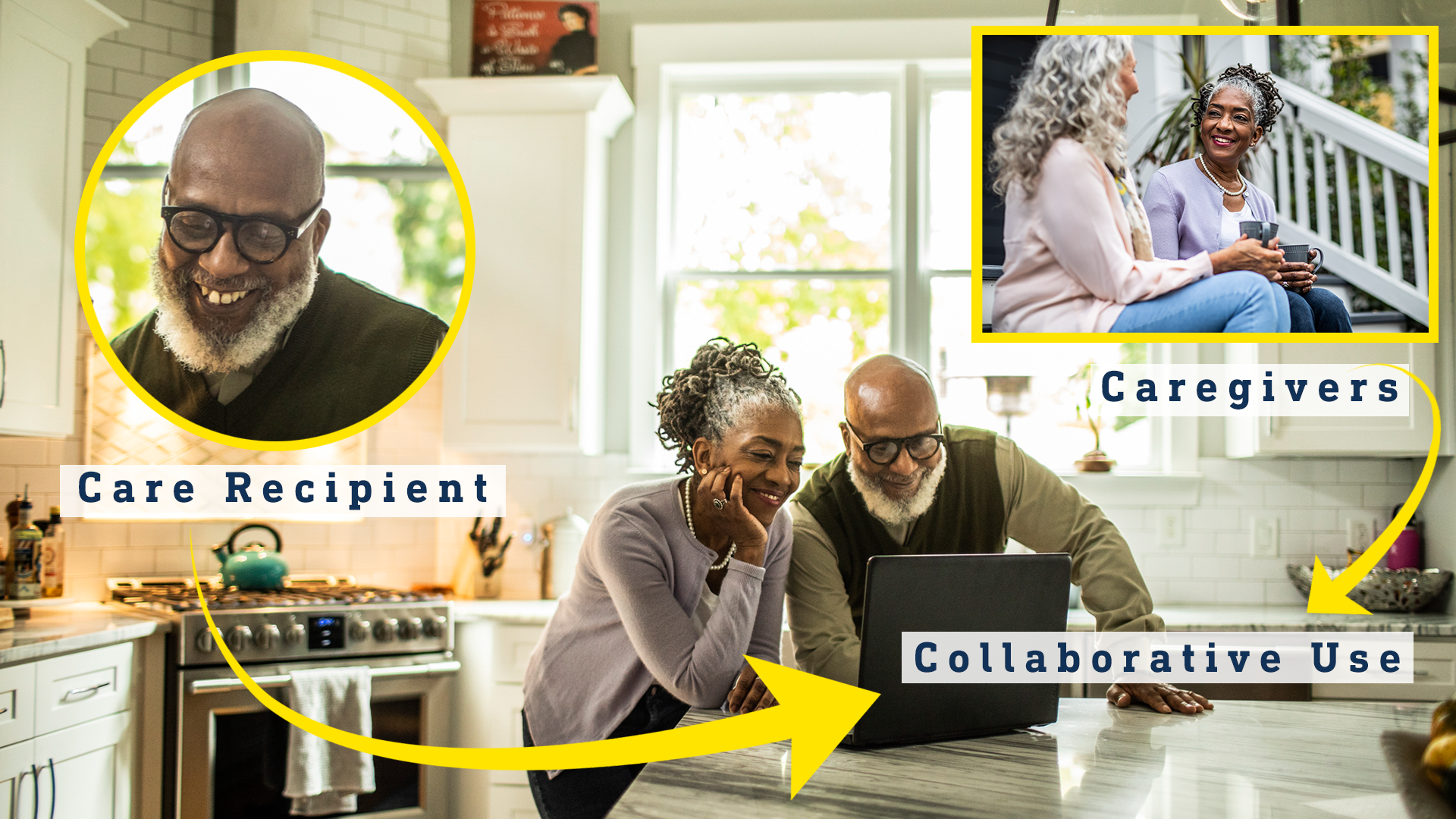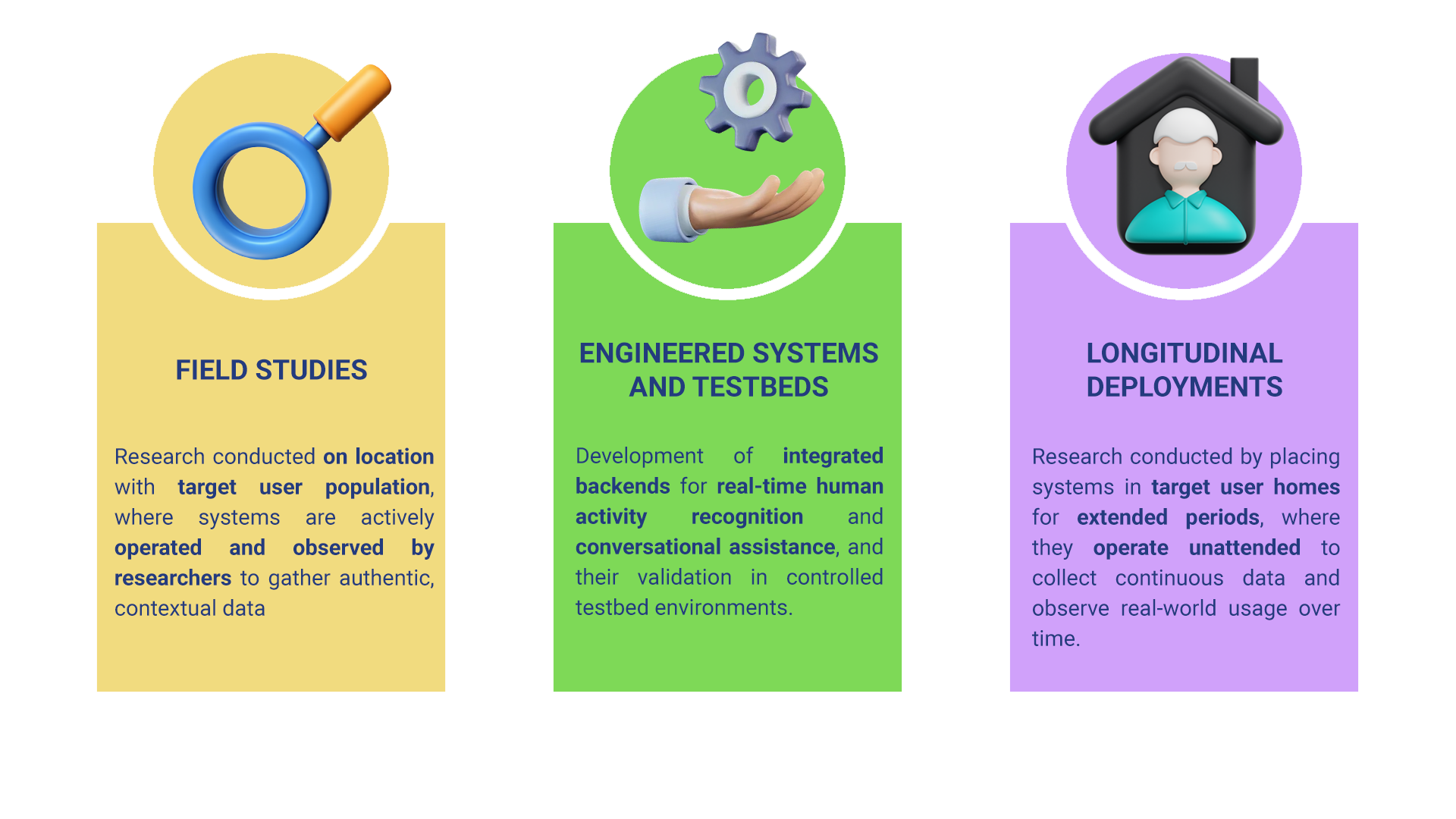
AI-CARING’s core mission is to develop integrative, interactive systems that help people sustain independence, create new opportunities for empowerment and meaningful quality of life, and improve the effectiveness of care coordination across family, community, and professionals, as well as to create new educational pathways to develop a larger and more diverse AI workforce. To achieve this mission, AI breakthroughs are required: we seek to create a vibrant, fully developed discipline focused on longitudinal collaborative AI—a field characterized by the design, development, and deployment of interactive, intelligent systems embedded within communities of users over extended periods of time (months and years). We envision agents that learn personalized longitudinal models of user behavior, recognize and adapt to changing user abilities, goals, and values, as well as the complex interpersonal relationships governed by those values. Building on such models, we envision networked teams of agents that provide coordinated assistance through personalized and value-driven interaction. Finally, collaborative human behavior is governed by complex social relationships, and we envision collaborative AI systems that operate in accordance with users’ norms and ethical considerations.
We are conducting long-term deployments in households with older adults, including people diagnosed with MCI, their family, informal care partners, professional providers, and community partners. AI-CARING systems aim to support tracking longitudinal changes, summaries and alerts for care partners, smart reminders, scaffolding complex tasks, exercise and physical wellness, conversational support for daily routines, care network coordination, and household robot assistance.
Researchers in computing, social sciences, and healthcare are collaborating to design, develop, and deploy AI systems that help people sustain independence, create new opportunities for empowerment and meaningful quality of life, and improve the effectiveness of family, community, and professional care. Results from this rich collaboration are providing the foundation for the theory and practice of longitudinal AI and establishing novel capabilities for collaborative intelligent systems.
The Institute was originally organized as:
Research Thrusts (RTs)
- The Personalized Longitudinal Interaction thrust focuses on modeling the behavior and style of users, to help support them and to detect and adapt to changes over time.
- The Robust Multiagent Coordination thrust focuses on networked collaboration between AI systems and users, including robust communication.
- The Socially-Conscious and Trustworthy AI thrust focuses on modeling trust, acting according to social norms, and behaving transparently.
Cross-cutting thrusts (CCs)
- The Ethics & Trust cross-cutting thrust focuses on identifying ethical and trust-related issues emerging from the development, deployment, and use of smart assistants for older adults.
- The Metrics & Benchmarking cross-cutting thrust focuses on identifying and developing metrics and evaluation methods for interactive AI systems.
The Institute introduced five Arenas to complement the above organization and serve as the mechanism by which use-inspired research, foundational AI, and cross-cutting themes were integrated across the Institute. Arenas were designed to evolve over time, with the possibility of renewal, extension, merge, or sunsetting, following the process outlined in the second version of the SIP and SIP Addendum. As the Institute’s research efforts matured, the review panel recommended “fewer but more integrative, bigger projects.” As a result, in Year 3, the Institute kept three Arenas but largely organized projects by Stakeholder and Capability, as outlined in Section 3.1.1, Characterizing the Needs of Older Adults and Their Care Network, in order to more directly reflect alignment with user needs. In Year 4, we maintained the Year 3 Stakeholder and Capability structure while significantly advancing our deployment efforts, as discussed below.
The Institute was initially organized as follows:
Research Thrusts (RTs)
- The Personalized Longitudinal Interaction thrust focuses on modeling the behavior and style of users, to help support them and to detect and adapt to changes over time.
- The Robust Multiagent Coordination thrust focuses on networked collaboration between AI systems and users, including robust communication.
- The Socially-Conscious and Trustworthy AI thrust focuses on modeling trust, acting according to social norms, and behaving transparently.
Cross-cutting thrusts (CCs)
- The Ethics & Trust cross-cutting thrust focuses on identifying ethical and trust-related issues emerging from the development, deployment, and use of smart assistants for older adults.
- The Metrics & Benchmarking cross-cutting thrust focuses on identifying and developing metrics and evaluation methods for interactive AI systems.
The research evolved and coalesced into five Arenas:
- Longitudinal Assessment
- Voice, Language, and Conversational Assistance for Daily Routines
- Kitchen, Cooking, and Meal Preparation
- Wellness: Social, Physical & Exercise
- Navigating Socially Complex Situations and Care Coordination
As the research continued to mature, these Arenas were further organized by stakeholders and capabilities.
Our AI research is grounded in stakeholder needs. Our work brings together an interdisciplinary team with the goal of enabling foundational AI research breakthroughs that lead to novel technology-based supports for older adults, including those experiencing cognitive decline, and their informal care networks. Key to the success of our work is aligning projects around these users and their real-world needs via close collaboration and co-design with our stakeholders.
We support two groups of end users:
- The older adult being supported, whom we refer to as the Care Recipient
- The network of individuals supporting them, which may include a spouse/partner, adult children, other family members, and professional caretakers, whom we refer to as Care Partners
In addition, we support a novel stakeholder group that we refer to as Collaborative Use, which occurs when two or more individuals are jointly using a technology, either collaboratively or with one individual facilitating and scaffolding the use of the technology by the other.

Our research focuses on use cases that benefit three groups of stakeholders, representing three different usage scenarios: care recipient, care partners, and collaborative use. To fulfill AI-CARING’s core mission to serve these stakeholders’ needs through interactive, intelligent systems embedded within communities of users over extended periods of time (months and years), we must deploy and validate our technologies with our target populations in real-world settings.
To provide tangible benefits to real users, we emphasize validating technologies with our target populations in their authentic environments. We prioritize in situ testing to capture genuine user interactions and contextual factors that influence system performance and user experience. This approach ensures that our solutions are not only theoretically sound, but also practically effective and user-centered.
Capable and responsible interactive AI systems require both contextual information about the user and knowledge about their prior interaction with the system. A home conversational agent that recognizes the occupant is in its vicinity through home sensors can proactively engage with them—checking in about their day, referencing the physical therapy exercises they completed that morning, and reminding them about an upcoming bingo event. This interaction is made possible through the integration of the various AI systems developed by our team.

All of the above efforts are grounded in our Use-Inspired Research methodology that brings together AI researchers with the stakeholders of our technology—aging adults and their care partners.
